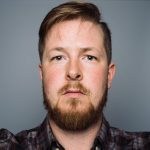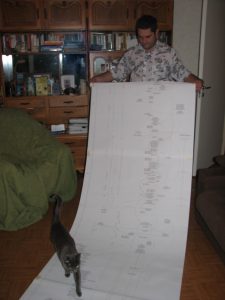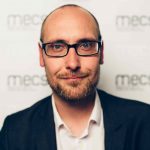Welcome to the Media Lab Doctoral Seminar on Thursday February 16th from 17:00–19:00, room 429 at Miestentie 3 (Otaniemi), 4th floor.
DOM-L0003 Doctor of Arts at Media Lab Seminar
Responsible teacher: Prof. Lily Díaz-Kommonen
Presentations by Tatu Blomqvist and Andrew Paterson. See abstracts below.
Tatu Blomqvist: Removing the frame: Documentary in virtual reality
Abstract: This research focuses on documentary storytelling in virtual reality. Journalists and documentarists have been excited about the narrative possibilities of virtual reality and it’s now being used in non-fiction storytelling on a regular basis. In my thesis I’m trying to find out how do the characteristics of virtual reality affect the production, presentation and viewing experience of documentary storytelling created with cameras. The research aims to understand virtual reality as a possible new documentary genre that is comparable to documentary film viewed on traditional screen or documentary photography, and that has its own patterns of production, distribution and use, making it distinguishable from traditional documentary genres. The research is located in the crossroads of new media, game studies, documentary film, journalism research and photography. The concept of camera image is central, as documentary photographs (and documentary film) traditionally rely heavily on the power of the indexical link between the image and the world. This trust in photographs as testimonies of past events is based on the iconic nature and the causal relationship that the photographic product has with real world events and objects. It can be argued that the indexical link makes documentaries created with cameras fundamentally different from journalistic games and virtual environments created with game engines. I’m trying to find out if virtual reality experiences as computer-generated simulations change the documentary genre, and how the search for immersion (e.g. head tracking, 3D sound or haptic feedback) change how documentary stories are made and experienced. The thesis includes analysis of published documentary virtual reality productions, empirical experiments of viewing experience and practice-based research in form of documenting my own art productions.
 Tatu Blomqvist is a doctoral student in Media Lab, interested in the future of journalism, photography and documentary film. He holds a Master’s degree in Social Sciences from the University of Tampere, where he studied Visual journalism and undergraduate studies in Photojournalism, Political science and International relations. Tatu has worked for almost 10 years in the fields of documentary photography and video for newspapers, magazines and humanitarian NGOs.
Tatu Blomqvist is a doctoral student in Media Lab, interested in the future of journalism, photography and documentary film. He holds a Master’s degree in Social Sciences from the University of Tampere, where he studied Visual journalism and undergraduate studies in Photojournalism, Political science and International relations. Tatu has worked for almost 10 years in the fields of documentary photography and video for newspapers, magazines and humanitarian NGOs.
Andrew Gryf Paterson : Autoarchaeologies / of an artist-organiser / (doing fieldwork) in Finland and Latvia
This doctoral dissertation is a contribution to practice-based, artistic research methodologies, named here as autoarchaeologies, and reflects upon my ‘artist-organiser’ practice over the durational period of 2009-2014 in Finland and Latvia.
In my practice I self-identify as an ‘artist-organiser’, who combines artistic and organisational working, including aspects of creative conceptual work, with curating, communications and cultural production, and social and community development in presence-based, remote and online networks. This position developed over 15 years in connection with Media Lab Helsinki, predominately working independently beyond academia, intensively in associational activities, collaborating with individuals and cultural organisations in transdisciplinary, hybrid practices, consisting of numerous processes, such as workshops, event-organising, and ‘artistic fieldwork’ in situ in various cultural festivals and non-arts-orientated venues, communities and localities; aswell as telling stories or narrating these activities in presentations or public discussions, reflecting and writing up texts as articles or essays as a reflective researcher. Whereas each activity—often undertaken as grassroots cultural or heritage activism—hoped for some more or less modest changes in society, artefact production (including fragments or traces of activities) and articles adds to understanding of experience, learnings and some gleaned answers about what one has been doing, and so towards better research questions or curiosities, that in turn inspires further practice.
Hence the thesis aims to address how hybrid practices such as my own meet the additional aspect of being a researcher who includes one’s own data in the analysis, as informed by autoethnography. Over time, I faced an emerging research problem which in interpreting and making sense of the relationship between my practice-based activities and experiences in multiple contexts, over a longer duration of time: How to present activities and experiences— that have happened as open-ended events and processes in multiple contexts over time— within the re-telling of practice-based artistic research, in my case, as an artist-organiser?
Inspired by earlier MSc thesis (2001) and following practice-led research in virtual, augmented and mobile media environments (2002-2006), I addressed the problem of authoring in spatio-temporal data structures, whereby I borrowed from the archaeological and geological practice of stratigraphy, which records inter-related strata (or loci in time-space) to chart inter-related contexts and durations in virtual and augmented environments. However, as my practice and research became more diverse over the years, and my experience accumulated, I saw the value of applying an archaeological perspective to my own practice that had become distributed in various locations over periods of time. The conceptual and literal stratigraphical mapping method suggested assistance towards answering the above question with a set of sub-questions: Where-when have been the foundations of different processes? What are the ‘red threads’ (and other colours too) of open-ended processes, and how have they developed or been sustained? What has been before or after or contemporaneous? In which directions has activity expanding beyond the periods of planned fieldwork or process? This updated stratigraphical method, when published (Paterson, 2011a) suggested some value of applying to ones own practice as a contribution to autoethnographical method of interpreting one’s own experiences and processes, described tentatively as an ‘auto-archaeological interpretation’. In the context of increased meta-data-augmented documentation of practices and everyday life via ubiquitous mobile computing and online publishing platforms, there is arguably increasing amount of personal (small or big) data to interpret and analysis. One archaeological theorist suggests, with access to multitude of data available about our own and others past activities, we are all (potentially) archaeologists now.
This article-based thesis is based upon five articles related to and based upon my artist-organiser practice. including the afore methodological article published in 2011, ‘Stratigraphical Recall: An auto-archaeological interpretation for artistic fieldwork’. The introduction offers background reflections on my practice, early influences, cultural and educational background and values which influenced me before I became a researcher. My aims and motivations, scope of research, knowledge, disciplinary fields that the thesis offers itself towards, is complemented by contextual introductions to the different cultural associations and venue-partners I have been involved with in Finland and Latvia. The methodological section introduces relationships to social science and fieldwork, to develop an understanding of autoethnography as it overlaps with an autoarchaeological approach. Recent developments in thinking in contemporary archaeological thinking and practice, considering the ‘contemporary past’, the stratigraphical record, and transdisciplinary application of archaeological approaches by artists and other practitioners are also referenced, to give support to the thesis. These questions can be summarized as seeking to understand the contextual chronology and genealogy of processes, using my own practice and experiences as example.
The four other articles included (2013, 2011b, 2010, 2016) are reflections upon the creative conception, motivations, organisation and broader social or theoretical context of four different processes I have been engaged in from approximately late 2008 to late 2015. Arguably they all have a different boundary object as the subject for multi- and trans- disciplinary inquiry, respectively the arctic crowberry, online videos, talkoot and soil. The order of the articles are presented in a mixed reverse order, with the latest one added at the end as a contemporary ‘bracket’ that mixes literally in practice many of the themes presented in the methodological approach. These are listed below.
These processes represented in the articles, all together, coincided and were inspired and supported by intellectually, and sometimes practically not only Pixelache Helsinki association and festival in Finland, but by the context of the Renewable Network, initiated by RIXC Centre for New Media Culture in Riga, 2009, still ongoing as a mailing list, research focus and symposia series by the Latvian cultural association and it’s regular partners, including myself. The Renewable Network supported and promoted the emergence of art-science and transdisciplinary research overlaps in region in various formats, including the social mapping of actors, projects and subjects in the Baltic Sea Region, but also further afield. These articles and acknowledged gaps raise up together better research questions as outgoing conclusions: How do seemingly disparate activities or agencies relate to each other? How do past, present and future practices relate to each other? How does linear- temporal objectification of lived experience and work relate to non-linear foldings and relationships of what I—and we—artistically organise, research, create, make and do?
See attached PDF for full information.
 Andrew Gryf Paterson (Scotland/Finland) is an “artist-organiser”, cultural producer, educator and independent researcher, based since late 2002 in Helsinki, Finland. He specialises in developing and leading inter- and trans- disciplinary projects exploring connections between art, digital culture and science, cultural activism, ecological and sustainability movements, cultural heritage and collaborative networks. What is left behind as social, digital, material and ephemeral residue of ‘being t/here’ has been a consistent concern. He has been closely connected to Pixelache Helsinki for 12 years, and completing his Doctoral of Arts thesis at Media dept. of Aalto University ARTS. More or less archived here: http://archive.org/details/@agryfp
Andrew Gryf Paterson (Scotland/Finland) is an “artist-organiser”, cultural producer, educator and independent researcher, based since late 2002 in Helsinki, Finland. He specialises in developing and leading inter- and trans- disciplinary projects exploring connections between art, digital culture and science, cultural activism, ecological and sustainability movements, cultural heritage and collaborative networks. What is left behind as social, digital, material and ephemeral residue of ‘being t/here’ has been a consistent concern. He has been closely connected to Pixelache Helsinki for 12 years, and completing his Doctoral of Arts thesis at Media dept. of Aalto University ARTS. More or less archived here: http://archive.org/details/@agryfp
 Biography: Dr Jussi Parikka is Professor at the Winchester School of Art (University of Southampton) and Docent at University of Turku. His various books have addressed a wide range of topics relevant to a critical understanding of network culture, aesthetics and media archaeology of contemporary technologies. The books include the media ecology-trilogy Digital Contagions (2007, 2nd. ed 2016), the award-winning Insect Media (2010) and most recently, A Geology of Media (2015), which addresses the environmental contexts of technical media culture.
Biography: Dr Jussi Parikka is Professor at the Winchester School of Art (University of Southampton) and Docent at University of Turku. His various books have addressed a wide range of topics relevant to a critical understanding of network culture, aesthetics and media archaeology of contemporary technologies. The books include the media ecology-trilogy Digital Contagions (2007, 2nd. ed 2016), the award-winning Insect Media (2010) and most recently, A Geology of Media (2015), which addresses the environmental contexts of technical media culture.

 Tatu Blomqvist is a doctoral student in Media Lab, interested in the future of journalism, photography and documentary film. He holds a Master’s degree in Social Sciences from the University of Tampere, where he studied Visual journalism and undergraduate studies in Photojournalism, Political science and International relations. Tatu has worked for almost 10 years in the fields of documentary photography and video for newspapers, magazines and humanitarian NGOs.
Tatu Blomqvist is a doctoral student in Media Lab, interested in the future of journalism, photography and documentary film. He holds a Master’s degree in Social Sciences from the University of Tampere, where he studied Visual journalism and undergraduate studies in Photojournalism, Political science and International relations. Tatu has worked for almost 10 years in the fields of documentary photography and video for newspapers, magazines and humanitarian NGOs. Andrew Gryf Paterson (Scotland/Finland) is an “artist-organiser”, cultural producer, educator and independent researcher, based since late 2002 in Helsinki, Finland. He specialises in developing and leading inter- and trans- disciplinary projects exploring connections between art, digital culture and science, cultural activism, ecological and sustainability movements, cultural heritage and collaborative networks. What is left behind as social, digital, material and ephemeral residue of ‘being t/here’ has been a consistent concern. He has been closely connected to Pixelache Helsinki for 12 years, and completing his Doctoral of Arts thesis at Media dept. of Aalto University ARTS. More or less archived here:
Andrew Gryf Paterson (Scotland/Finland) is an “artist-organiser”, cultural producer, educator and independent researcher, based since late 2002 in Helsinki, Finland. He specialises in developing and leading inter- and trans- disciplinary projects exploring connections between art, digital culture and science, cultural activism, ecological and sustainability movements, cultural heritage and collaborative networks. What is left behind as social, digital, material and ephemeral residue of ‘being t/here’ has been a consistent concern. He has been closely connected to Pixelache Helsinki for 12 years, and completing his Doctoral of Arts thesis at Media dept. of Aalto University ARTS. More or less archived here: